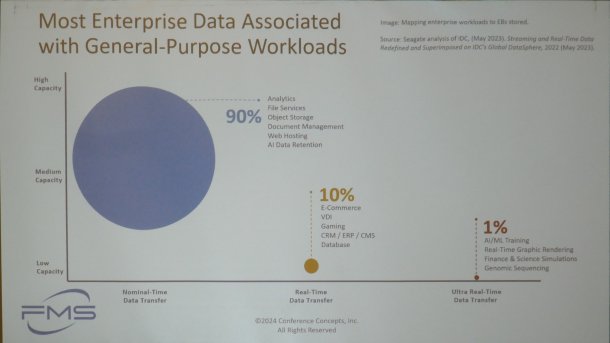FMS: Seagate invokes the cooperation of hard disks and SSDs
The FMS is now also about hard disks. Although Seagate had no new products to announce, it did provide interesting insights into current technology.

Despite the current hype, AI only needs a small part of the total storage capacity of all drives.
(Image: Seagate)
- Lutz Labs
Artificial intelligence is also one of the main topics at the FMS, and this requires fast SSDs. However, hard disks are also suitable for data storage and many other applications: according to Seagate technologist Praveen Viraraghavan, 90 percent of all enterprise data is stored on hard disks. Viraraghavan cited file servers, object storage and document management, for example. A further 10 percent, for example databases, e-commerce applications or gaming, require SSDs, and the last percent, which is certainly the result of a rounding error, requires extremely fast SSDs, for example for AI training, scientific simulations or gene sequencing. According to the Seagate manager, however, the ratio is likely to shift partially over the next few years: AI applications are just getting started; he cited, for example, the creation of a 90-minute feature film from a 10-page AI prompt as a possible application – in ten years or so.
One of the reasons why hard disks are still being bought is certainly the price. This is 20 to 30 percent of what you have to spend on an SSD with the same capacity and quality level. Money also plays a role in the second reason: last year, flash manufacturers produced around 333 exabytes of memory, and output in 2027 is estimated at 963 exabytes. However, the augurs at IDC and Trendforce put the storage requirement for 2027 at 3686 exabytes, i.e. 2723 exabytes more. We cannot estimate the cost of building suitable factories, but it will certainly be many hundreds of billions of euros.
In the future, private users will probably continue to purchase hard disks, primarily in the form of USB drives, for backup purposes. Hard disks will continue to be significant in data centers.
Nanometer airplane
Viraraghavan then gave some more technical details about the current Seagate drives. For example, the flying height, i.e. the space between the disks rotating at 7200 revolutions per minute and the read/write heads, is just 1 to 2 nanometers. As an illustrative comparison, he cited an Airbus 380 flying at 1000 km/h half a meter above the turf. Another comparison: the heads hit a track with a maximum deviation of 3 nanometers. This is similar to a car driver who has his steering wheel so well under control at 80 miles per hour (128 km/h) that he deviates a maximum of 5 water molecules to the left or right.
Seagate has also made progress with the HAMR development. The company has already built a hard disk with 40 TByte, but it is not yet ready for production. Seagate has replaced the relevant parts, i.e. the magnetic disk, laser and plasmonic transducer, with further developments. The plasmonic transducer serves to "miniaturize" the laser beam. At several hundred nanometers, this is far too wide for the tracks, which are only a few tens of nanometers wide, while the plasma output of the transducer is adapted to the track width.
The power consumption of the HAMR drives has increased compared to the previous models. The helium-filled drives now consume up to 9.6 watts, while the disks without HAMR technology, which are also filled with 10 disks, are content with around 8 watts. However, the HAMR drives perform better than the older models in terms of watts/byte, an important parameter for TCO considerations.
On the other hand, there is a positive trend in the permissible workload: While the so-called workload, i.e. the maximum amount of data read and written, is a total of 550 TByte per year for the old Exos models, Seagate has increased the permissible load under warranty for the HAMR drives to 700 TByte.
(Image: Seagate)
Seagate is confident that it can build drives with up to 80 TByte with HAMR technology. Other technologies, such as the 3D HAMR recently developed by Japanese researchers, could also work, but the road to a production-ready process is still long, said Mohamad El-Batal, Chief Technologist in the CTO Office, when asked.
The capacity gain through HAMR comes primarily from the increase in tracks, which are simply closer together. The number of bits in a track, on the other hand, has only increased by 5 to 8 percent. One of the next development steps will therefore also involve the media, so that more data fits into the tracks. SMR disks are also conceivable with HAMR, but the researchers are not currently working on HIMR (Heat Assisted Interlaced Magnetic Recording), which works with different laser powers.
The number of tracks on a modern hard disk, the so-called platter, is between 750,000 and 800,000. The different values result from errors in the production process. Seagate records which of the tracks are defective for each individual platter in an internal database and, of course, on the disk itself. This is one of the reasons why the start-up of a hard disk takes a certain amount of time and is sometimes even artificially slowed down: The hard disk must first read various data for its own initialization before it is ready for operation. And that takes time with hard disks.
Hard disks with a PCIe interface and NVMe protocol, as defined by Seagate together with Western Digital and Microsoft in the Open Compute project, promise a faster start. Such hard disks use parts of the operating system DRAM via the NVMe driver and can read these values directly from there, which should be much faster. However, according to El-Batal, Seagate does not expect the impetus from the industry to build such hard disks until 2027 or 2028. (ll)